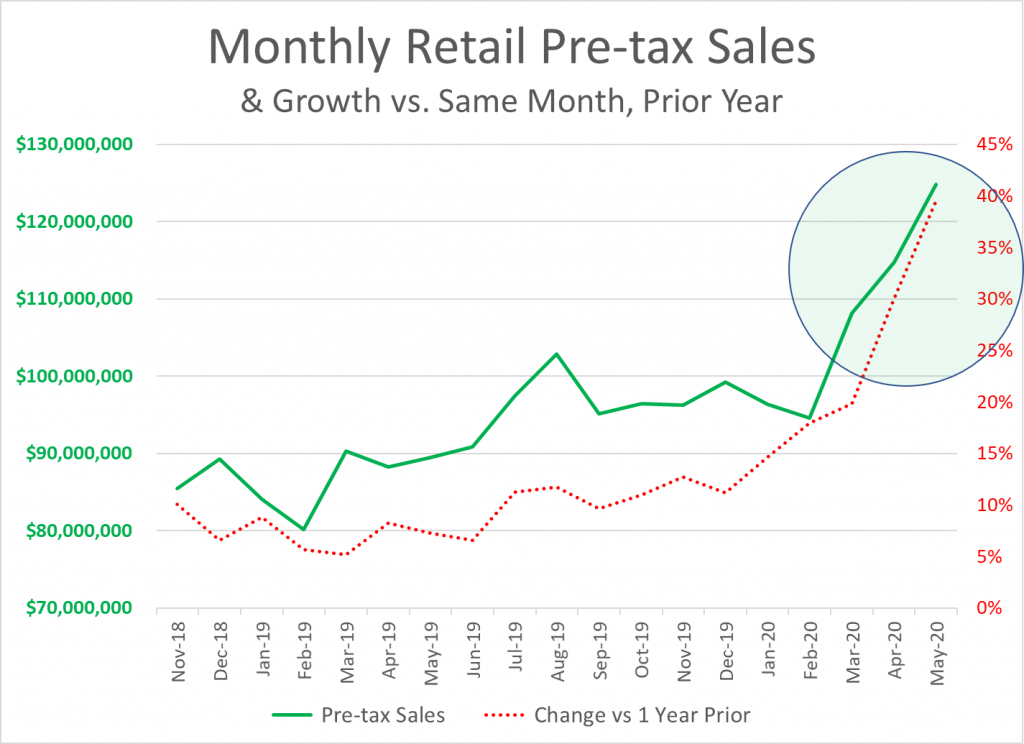Washington State’s newest essential service is exceeding all expectations when it comes to meeting the essential needs of it’s cannabis consumers and the ever more dire revenue generation needs of the state.
May pre-tax retail sales numbers at the licensee level were released this past Friday. Just as April beat the record set for sales in March, May has raised the bar yet again for those wondering how much cannabis can be sold in a state of this size in a given month.
While I’m not sure exactly what is going on to explain this accelerating spike in cannabis sales, it would seem reasonable to postulate that at least two things are happening:
-existing cannabis consumers are consuming more cannabis than they typically do
-new cannabis consumers are entering the market at a higher rate than has recently been the case
Both of these ring true to me.
Folks afraid of going out and doing other things can always stay at home. At least some of them will have discovered that smoking cannabis not only helps deal with the new stresses of being under a constant state of emergency and near-martial law, but also that it is easier to smoke more of it more frequently when one is not physically at work 9-5 M-F (for example) and when one is not driving nearly as frequently. Some will also have realized that, given the choice to increase drinking or increase cannabis use or increase the use of some other psychoactive compound that increasing the use of cannabis is likely the safest of those alternatives.
There are also likely quite a few older folks that had tried cannabis back in their youths and opted to stop when mainstream careers took over. As the country (and, to a lesser degree, rest of the world) goes through a fairly fundamental upheaval, many of these people are finding themselves not going to the office (or, more generally, workplace) as they once did and are beginning to see the possibility that they may never go back. Couple the decrease in concerns about cannabis use being inconsistent with unwritten (or written) office rules governing personal conduct in the workplace they recently occupied with the fact that cannabis is now legal in this state and some of them may have decided to finally get back into doing the drug they had enjoyed so much as youth.
Whatever the reason(s), cannabis retail sales in Washington are taking off like never before seen.
As I mentioned in my previous article focusing on retail and tax revenue, the only month prior to this time of pandemic that had seen more than $100 million of retail sales (all sales mentioned in this article will be pre-tax sales) was August of 2019.
The level of sales seen during that Hempfest-assisted time was $102 million.
Per the sales data just released by the WSLCB, March saw $108 million in sales, April saw $115 million in sales and May saw just under $125 million in sales.
The 12 months ended May saw a total of $1.21 BILLION in retail cannabis sales. That represents almost 25% more than is estimated in the forecasts used by our legislators in planning for the next budget cycle.
More to the point, the extreme growth seen (vs the same month one year prior) in each of the past three months is accelerating. While March was 20% higher than the year prior, April was 30% higher and May was 40% higher.
If these past three months are any indication of what future cannabis consumption trends in the state will be, then annualized numbers on the order of $1.4 BILLION dollars of sales could be expected during Fiscal year 2022.
Were that to happen, tax revenues to the state would be on the order of $200,000,000 higher than was forecast by the Economic Forecast Research Council just last month.
Here is a graph summarizing the trend in monthly pre-tax retail sales and the year-on-year growth seen in each month.

An alternate view for why sales have increased is that the WSLCB has been largely absent from the job since the killer ‘Rona took hold of our society. When incompetent regulators step aside, incompetent regulation takes a break and capitalistic commerce can thrive.
Perhaps the WSLCB should be added to the list of agencies in need of a serious reduction in funding. If their inattention can result in hundreds of millions in unanticipated tax revenue, their absence might mean even more.
On the flip side of the equation, if the state does not do something soon to correct the failed path the WSLCB doggedly continues down with their incompetent and disengaged traceability vendor, the Feds may one day wake up to the fact that Washington is currently only pretend-regulating it’s cannabis industry while at the same time the WSLCB is incapable of keeping track of product flows throughout (let alone outside of) the regulated market.
It would be great to see hundreds of millions of extra tax revenue from this market to help balance the budget over the next year or two. It would be a bummer seeing that revenue crash to zero in the face of Federal intervention. The WSLCB has engineered a situation in which Federal intervention in Washington State’s market would now be justified — in the name of both public safety and health.
More on that shortly.